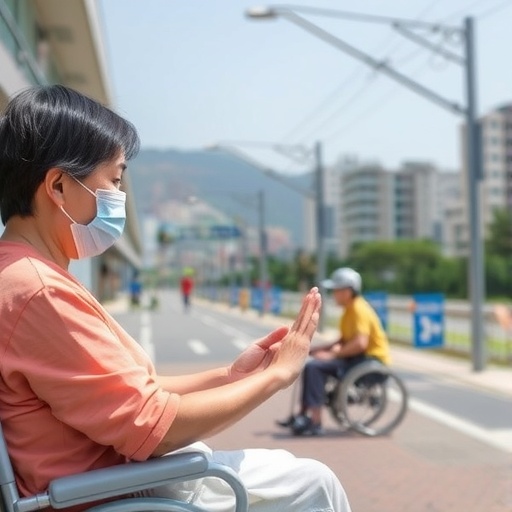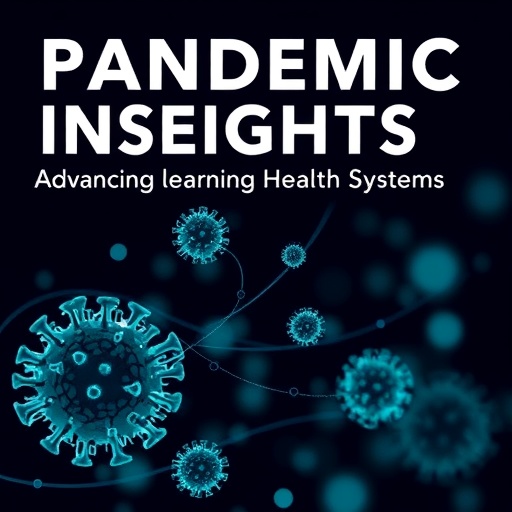
In a groundbreaking new study published in Nature Communications, researchers have unveiled critical insights into the relationship between rising temperatures and hospitalization risks among people with disabilities in South Korea. As global climate patterns shift and heatwaves grow more frequent and severe, understanding vulnerable populations’ responses to these environmental stressors has become an urgent public health priority. This comprehensive investigation offers a technical yet accessible exploration of how heat exposure disproportionately affects individuals with disabilities, revealing nuances that could inform future climate resilience policies and healthcare strategies.
The study, authored by Park, Kim, Al-Aly, and colleagues, leverages extensive epidemiological data and sophisticated statistical models to quantify the heightened risk of hospitalization that comes with exposure to extreme heat for disabled persons. South Korea, with its rapid urbanization and aging population, presents an ideal case study to explore these dynamics. The team employed a nationwide cohort approach, integrating meteorological records with healthcare utilization data, to dissect the multiple layers of vulnerability associated with disabilities under heat stress conditions.
Heatwaves have long been recognized as deadly events, with considerable morbidity and mortality worldwide. However, populations with pre-existing vulnerabilities, such as individuals with physical or cognitive disabilities, often face compounded risks that remain insufficiently characterized. This research addresses the pressing gap by focusing on a demographic often sidelined in climate risk assessments. By correlating daily maximum temperature metrics with hospital admission records over several years, the study rigorously identifies a statistically significant escalation in heat-related hospitalizations among disabled individuals compared to the general population.
The authors applied advanced time-series regression techniques to control for confounding variables like air pollution, humidity, and seasonal trends that might otherwise obscure true associations between heat and health outcomes. The inclusion of interaction terms allowed them to explore differential effects across age groups, disability types, and urban versus rural settings. One notable finding is that neurological impairments and mobility limitations correlate with the highest relative increases in hospitalization risk during heat events, likely reflecting the complex physiological and social support vulnerabilities in these subgroups.
Physiologically, heat stress triggers a cascade of bodily responses including dehydration, electrolyte imbalance, and cardiovascular strain. These challenges are exacerbated in people with disabilities who may have impaired thermoregulation, reduced mobility preventing effective cooling behaviors, or reliance on caregivers whose availability may be disrupted during extreme weather. The study delves into the pathophysiological mechanisms, emphasizing how comorbid conditions common among disabled populations further amplify the danger. For example, autonomic dysfunction in spinal cord injury patients can hinder sweating, impeding the body’s natural cooling process and increasing heat retention.
Beyond biological vulnerability, the research highlights critical social determinants that mediate heat exposure risk. Disabled individuals frequently experience socioeconomic disadvantages, social isolation, and barriers to accessing healthcare or adaptive technologies, compounding their susceptibility to heat. The authors contextualize their findings within the framework of environmental justice, underscoring how climate threats intersect with existing inequalities to perpetuate health disparities. This multifactorial perspective advances the discourse from purely biomedical explanations toward comprehensive, equity-focused understanding.
Importantly, the study’s methodology employs spatial analyses that map hospitalization risk hotspots in relation to urban heat islands and neighborhood socioeconomic status. South Korea’s densely populated metropolitan areas exhibit sharp gradients in temperature and infrastructure resilience, disproportionately impacting residents with limited resources and mobility who cannot easily evacuate or seek refuge in cooled environments. These geospatial insights offer critical guidance for targeted interventions, suggesting priority zones for cooling centers, outreach programs, and resource allocation.
The research team also integrates projections of future climate scenarios, using downscaled climate models paired with demographic data, to forecast how heat-related hospitalization burdens may evolve over coming decades. Their predictive modeling warns of significantly increased healthcare demands among disabled populations unless adaptive measures are urgently implemented. Such foresight is vital for public health planning and underscores the necessity for climate-sensitive disability policies embedded within national health systems.
This investigation departs from prior research by explicitly focusing on the intersection of disability and extreme heat in an East Asian context, where rapid industrial development and urban growth accentuate environmental vulnerabilities. The authors provide thoughtful discussion on cultural and policy factors influencing heat risk mitigation, including the adequacy of current disability support programs and emergency response mechanisms in South Korea. Their recommendations propose integrative approaches combining medical, social, and environmental strategies to reduce heat-related adverse outcomes.
Technically, this paper represents a robust example of interdisciplinary collaboration, merging environmental science, epidemiology, and disability studies. The use of large-scale register data, combined with rigorous statistical controls and nuanced subgroup analyses, sets a new standard for research in climate-health intersections. It also underscores the importance of disaggregated data collection to illuminate differential health impacts across diverse populations, facilitating equity-driven public health interventions.
As heatwaves intensify under climate change, this study serves as a clarion call for policymakers and healthcare providers to prioritize the needs of disabled individuals. Basic mitigation strategies—such as improved access to cooling centers, adaptive building design, flexible caregiving support, and real-time heat warnings tailored for vulnerable groups—are urgently needed. Moreover, these findings advocate for enhanced training of medical professionals to recognize and address heat-related illness manifestations specific to disabilities.
In conclusion, the research by Park et al. illuminates an underrecognized but critically important facet of climate vulnerability: the disproportionate burden of heat-related hospitalization among people with disabilities. Through meticulous data analysis and a holistic lens on human-environment interactions, the study offers actionable knowledge poised to influence public health planning and climate adaptation strategies. As societies worldwide confront escalating heat exposure, incorporating disability considerations into resilience frameworks will be essential to safeguard health and equity.
The study’s implications extend beyond South Korea, signaling a universal imperative to integrate disability into climate risk assessments and emergency preparedness plans globally. Future research building on this work could explore longitudinal health outcomes post-hospitalization, efficacy of targeted interventions, and cross-national comparisons to refine global strategies. Ultimately, safeguarding disabled populations against heat hazards is both a moral and pragmatic priority as climate change reshapes the landscape of human health.
Subject of Research: Heat exposure and hospitalization risks among people with disabilities in South Korea
Article Title: Heat and hospitalization risks among people with disabilities in South Korea
Article References:
Park, J., Kim, A., Al-Aly, Z. et al. Heat and hospitalization risks among people with disabilities in South Korea.
Nat Commun 16, 4040 (2025). https://doi.org/10.1038/s41467-025-59270-8
Image Credits: AI Generated
Tags: climate resilience policiesdisabled individuals and climate changeenvironmental stressors and healthepidemiological data on heat exposureextreme heat effects on disabilitiesHeatwaves and hospitalization risksmorbidity and mortality from heatwavespublic health priorities in South KoreaSouth Korea healthcare strategiesstatistical models in health researchurbanization and health impactsvulnerability of disabled populations





